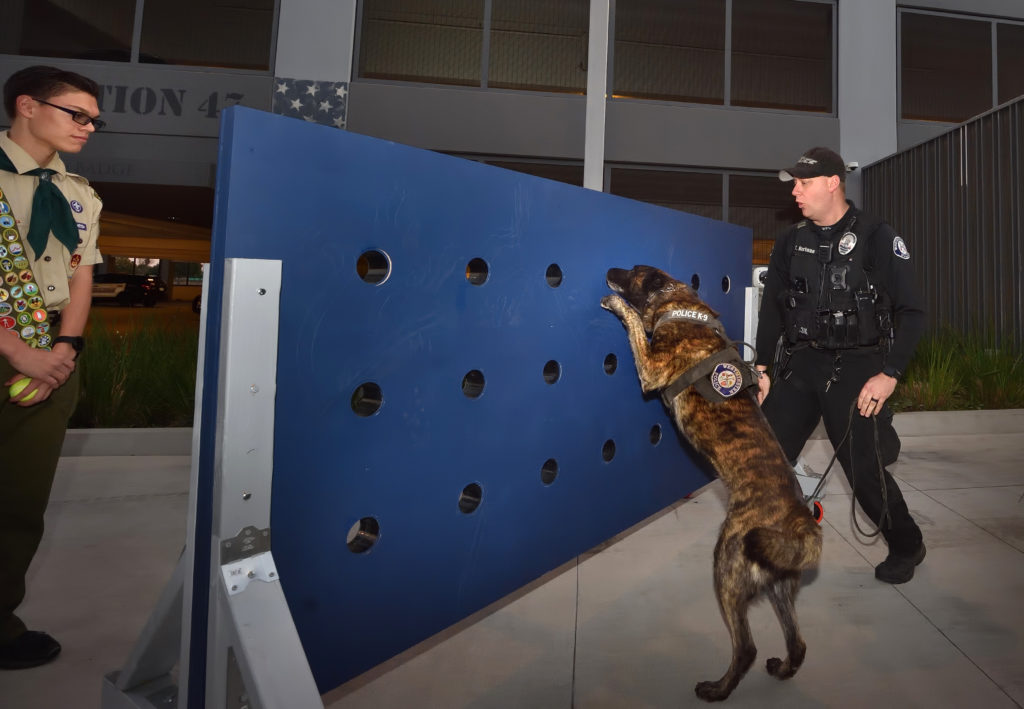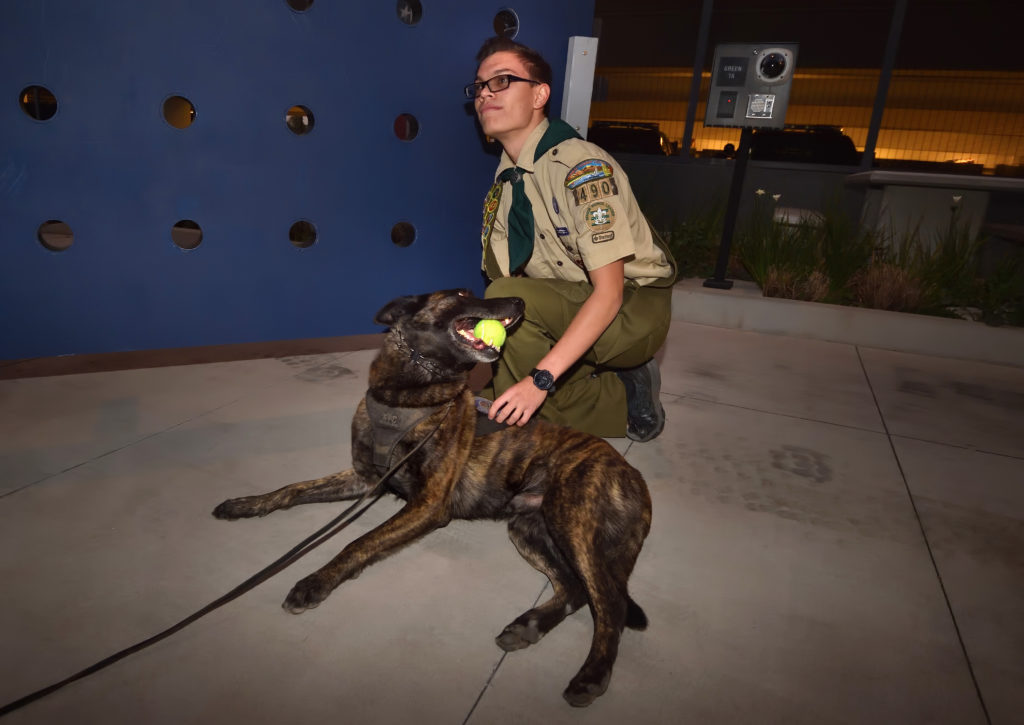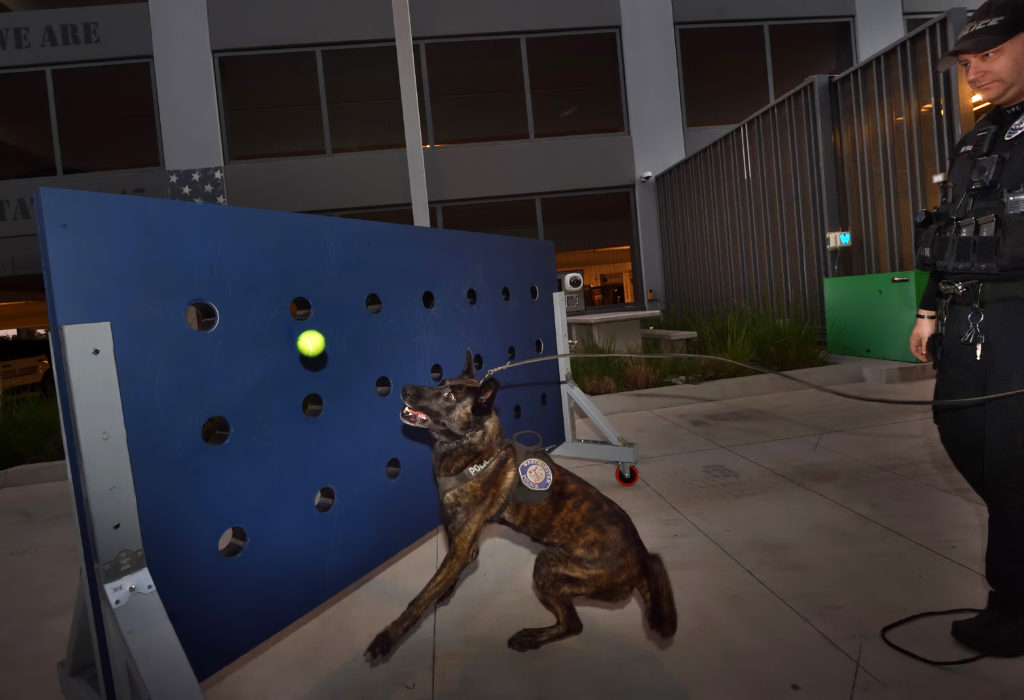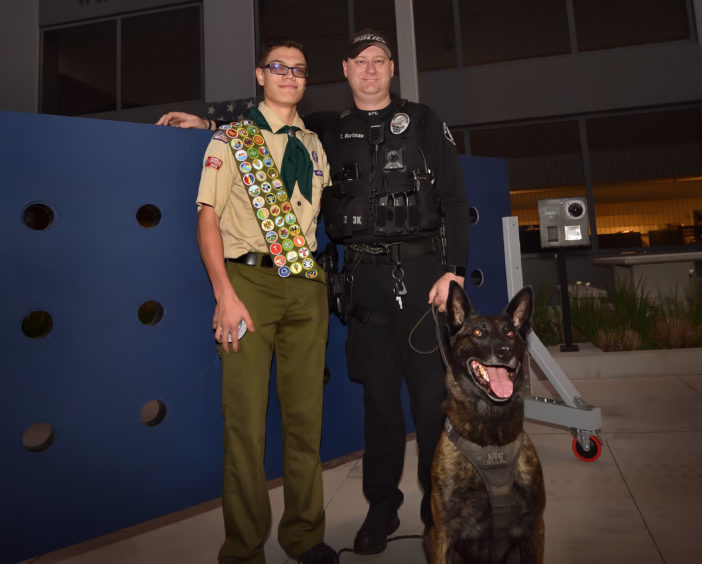When 16-year-old Jared Fong learned from Westminster PD Sgt. Dave Ferronato that the agency’s K9 program needed a new training tool, Fong was eager to help.
“We had to do a project which serves our community,” said Fong, who has been a Boy Scout for six years and was working on his Eagle Scout Project. “These people risk their lives for us all the time.”
As assistant Scoutmaster for Boy Scouts Troop 490, Ferronato likes to keep the troop apprised of needs the agency has that might make good projects for the Scouts. With 8-year-old Dutch shepherd K9 Pako newly certified as a narcotics dog, he and his partner, WPD Officer Travis Hartman, were in need of a very specialized training tool: a narcotics wall.

Westminster PD Officer Travis Hartman guides his K-9 partner, Pako, to each hole as Pako uses his nose to locate which hole contains a small amount of narcotics. Eagle Scout Jared Fong, left, built two K-9 training walls for Westminster PD and donated them to the department.
Photo by Steven Georges/Behind the Badge
“You built the first one for our agency — ever,” Hartman said to Fong at a small demonstration at the agency on Feb. 6 when Fong was able to see Pako use the new wall.
The narcotics wall was actually two walls — the other is reserved for new WPD K9 Ranger, in case he becomes a narcotics dog in the future. They are each made of wood and reinforced with steel, and weigh about 150 pounds each. Normally a narcotics wall costs an agency anywhere from $1,000 to $1,500 each.
Painted blue, Fong — with the help of other Scouts — built the walls with rows of holes. Both walls were also built with rollers so they can be moved around — a request made by Hartman, who said narcotics walls are normally stationary. Adding the rollers gives Hartman the ability to take the wall anywhere he needs to train (most of Pako’s training takes place outside the agency).

Eagle Scout Jared Fong holds the custom built duel tube where a small amount of narcotics or gun powder is placed at the back of the tube and the other is attached to the back of the K-9 training wall. If the police K-9 is able to correctly sniff the correct hole, a tennis ball is dropped into the top of the tube to reward the dog.
Photo by Steven Georges/Behind the Badge
Along with the walls, Fong created canisters to precisely fit the holes in the narcotics wall. These canisters (or “scent chambers”) are used to hold the narcotic Pako is supposed to find by its scent.
“We’re teaching the dog to search on different planes,” Hartman said, adding that the rows of holes can be used to teach Pako to sniff out the narcotics at varying heights by placing the canister in different holes.
Hartman demonstrated two ways he could use the wall as a training tool for Pako — by himself and with a helper.

Eagle Scout Jared Fong with Westminster PD’s K-9, Pako. Fong build and then donated two K-9 training walls, one of which is behind him, to Westminster PD.
Photo by Steven Georges/Behind the Badge
Without a helper, Hartman can simply place the canister in any given hole, wait for Pako to alert him to where on the wall the scent is coming from and give Pako his toy as a reward.
With a helper — in this case Fong — once Pako alerted to the correct location of the narcotic, Fong was able to push a yellow tennis ball through the canister, which bounced out to Pako’s great enjoyment.
“Works pretty well, huh?” Hartman said to Fong.
During the demonstration, Pako had no trouble scaling the wall to search for scents. But Fong wasn’t worried. Knowing the walls would take a beating, Fong made sure to test them thoroughly.
“We had kids running into it, testing it,” he said.
Hartman did some testing of his own.
“It holds up with me sitting on it,” he said.

Westminster PD’s K-9, Pako, gets his reward, a green tennis ball, after correctly identifying which hold held the narcotics.
Photo by Steven Georges/Behind the Badge
Ferronato said that as part of an Eagle Scout Project, Scouts must learn to fundraise as well. Fong sent out solicitation letters to local businesses. Ferronato gave him another idea.
“I told him, send one to the police department association,” Ferronato said.
Fong did and requested $200. The Westminster Police Officers’ Association ended up donating $700 — which covered 90 percent of the cost of the walls.
“It’s a very nice gesture for the POA to support them,” said Ferronato.
Before Fong and his father, Dan, left the demonstration, Hartman gave the Scout a gift.
“As a thank you, this is our new division patch,” Hartman said, handing the new K9 design to Fong. “Nobody in the public has that yet.”
“Thank you so much,” said Fong. “It’s amazing.”
 Behind the Badge
Behind the Badge



